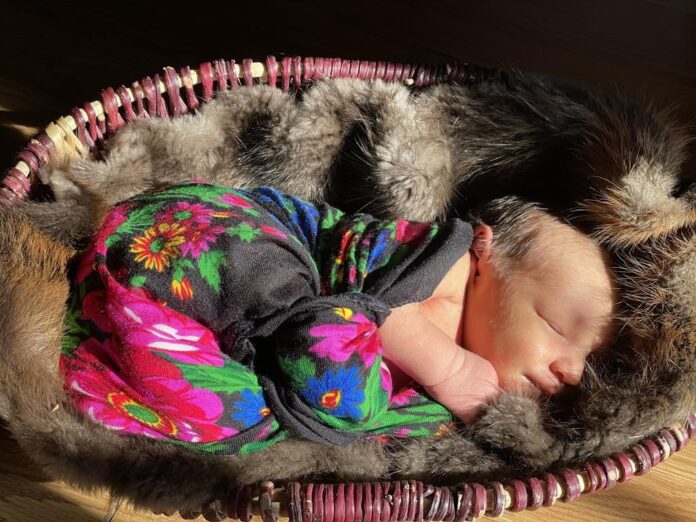When Kaleo Joseph Gary Rabbitskin burst into the world last month, his birth marked a turning point for his community.
It was the first time in 50 years a baby was born in Sturgeon Lake First Nation with traditional Cree birthing practices.
“When the baby was born, it was into a warm, welcoming environment supported by the sacred fire, by the welcoming ceremony,” said Shirley Bighead, director of Sturgeon Lake First Nation Health Centre in Saskatchewan.
Sturgeon Lake, like many First Nations, was long unequipped for high-risk pregnancies and lacked midwives to support a traditional birth. That meant for the past five decades, mothers have had to travel hundreds of kilometres off-reserve to give birth in hospitals outside Indigenous communities.
But when Ashley Rabbitskin delivered Kaleo on Feb. 23, she was surrounded by close family as she gave birth, including her mother and aunts.
“It just came to full circle of having my daughter deliver with a midwife, just like I was delivered with my auntie and my mother,” said Ashley’s mother, Norma Rabbitskin, who is also a senior nurse at Sturgeon Lake Health Centre.
Indigenous mothers are more likely than their non-Indigenous counterparts to travel more than 200 kilometres to give birth, according to a study conducted by the Canadian Medical Association Journal.
The same study found that the geographic isolation of Indigenous communities from birthing facilities and systemic inequities in access to prenatal and maternal health care are also key factors in forcing Indigenous mothers to travel extraordinary distances to give birth without their loved ones around.
Sturgeon Lake leaders want to make Ashley’s experience a regular occurrence and is developing band legislation that normalizes traditional births within the community.
“Birthing is an inherent right, nothing that we ever gave up. We wanted to take (mothers and babies) away from the cold, sterile environment … in acute care centres,” said Bighead.
The legislation — hopefully in place by the end of next year — will be informed by Sturgeon Lake’s knowledge system and Cree creation stories, cultural practices surrounding maternal-infant health, the recruitment of new midwives and transferring knowledge of traditional birthing to new and expectant mothers.
Trending Stories
Russian NHL star Ovechkin faces calls to ‘do more’ to condemn Ukraine war
Grimes accidentally reveals birth of 2nd child with Elon Musk
Quebec doulas and mothers-to-be sounding alarm over rules shutting them out of hospitals – Feb 15, 2022
A traditional Nehiyawak — or Cree — birth involves sacred ceremonies and teachings that the mother partakes pre- and postnatally. But hospitals off-reserve don’t meet the cultural needs of a Cree birth.
“It was what’s missing — that spiritual care and all that emotional care that our elders provide,” said Bighead.
Sturgeon Lake took over its health services from Health Canada in 1995 but it took another 27 years for a baby to be born right in the community.
Nearly a whole decade after that was spent tackling administrative hurdles and gathering funding to get the project off the ground.
Even after that, it has taken 15 years of consultation, planning and training to implement a comprehensive program for a mother to be able to deliver her baby in Sturgeon Lake, said Norma.
“It’s been a passion of the community to revitalize birthing,” she said.
Training midwives who are already on-reserve will make deliveries for mothers in remote areas cheaper, according to data provided by the National Aboriginal Council of Midwives.
There are currently 11 pregnant women and 36 mothers in total learning the Nehiyawak practices of birthing in a pilot program in Sturgeon Lake.
The community is going to build a birthing centre which is central to the new legislation, equipped with tools from western and traditional medicine. It will be designed with spiritual and ceremonial values in mind, said Sturgeon Lake band health councillor Christine Longjohn.
“All of our teachings come from preconception to death, so this is a lifelong process that mothers are going into,” she said.
Those teachings will inform the architectural layout of the new birthing centre, she added.
The doorway will face south, the direction that all ceremonial and sacred doorways in Cree culture face, Longjohn said. It will have four birthing suites, a teaching room with a sacred fire in the middle, family resting rooms and a dining area.
“I think it’s all very well and good to talk about sovereignty and jurisdiction and autonomy,” said Bighead. “But I believe what we’re doing is actually practising that, not just talking about it.”
———
This story was produced with the financial assistance of the Social Sciences and Humanities Research Council, which is funding a project by Carleton University’s School of Journalism and The Canadian Press.
© 2022 The Canadian Press



